Morris
Weiss, Mickey Finn and the Palooka
A Visit with
One of the Most Durable of the Laborers in Cartooning’s Vineyards
ONE DAY IN
1934, the faux “radio announcer” in Ed Wheelan's Minute Movies comic strip made a cryptic request: "If Morris Weiss is listening,"
he said, "let him get in touch with Ed Wheelan."
Weiss
missed seeing the strip, but a friend told him about it, and when he phoned
Wheelan, the veteran cartoonist asked the 19-year-old freshly graduated High
School of Commerce student if he'd like to do the lettering on Minute
Movies. That was the beginning of Weiss's 42-year career as a cartoonist.
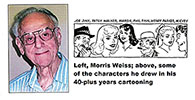
At
the time, Weiss was trying to decide between cartooning and illustrating as a
career. New York's High School of Commerce was conveniently located in midtown
Manhattan (where Lincoln Center is now), and Weiss took advantage of the
convenience to call upon as many illustrators and cartoonists as he
could—asking advice, showing his work, collecting original drawings.
"I
met Charles Dana Gibson," Weiss recalled when we talked in October
1992, "and James Montgomery Flagg and all the famous comic strip
artists— Edwina Dumm, the dearest, sweetest person, who was very nice to
me, who was then doing the Sinbad page [about a mischievous little dog] for the
old Life magazine and her comic strip, Tippie and Cap Stubbs.
Gibson, a kindly gentleman, said to me, I was like you once, young and
ambitious. Flagg wouldn't let me leave his apartment after drawing me until an
old friend arrived, William S. Hart. 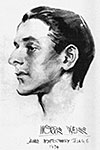
"Among
the giants I have been privileged to meet," he continued, "were Harvey
Dunn, a great painter among illustrators and a powerful presence of a man,
who told me that you had to feel a painting in order to paint
it. And Billy DeBeck, who told me he learned how to draw with a pen by
copying Gibson's illustrations, line-for-line. And when he was broke, he sold
them for five dollars each in bars in Chicago—as Gibson originals!"
But
Weiss's cartooning career was not destined to take flight from the launching
pad of Wheelan's strip. "I tried hard," Weiss said, "but I
couldn't master the 170 Gillot point for lettering. After a week, he let me
go, and I understood why."
A
few weeks later, Weiss heard that Pedro "Pete" Llanuza was
looking for an assistant on Joe Jinks. Having found a penpoint more
congenial to his hand, Weiss became Llanuza's assistant, doing the lettering,
inking the backgrounds, cleaning up the art, and delivering the strips to the
syndicate office. "He paid me six dollars a week," Weiss said.
"And after four months, he gave me a raise to seven dollars a week."
Seeking
to increase his income, Weiss applied to Harold Knerr to do the
lettering on The Katzenjammer Kids. Later, he joined the Max Fleischer
Studios as an opaquer, his first full-time job, leaving Joe Jinks but
continuing to letter for Knerr in his spare time.
Weiss's
big break came in the spring of 1936—partly as a result of a Christmas card he
produced the previous year. Designed as a promotional piece as well as a
seasonal greeting, the card showed young Weiss at his drawingboard and, pinned
to the wall behind him, his copies of the original drawings he'd received from
cartoonists and illustrators. 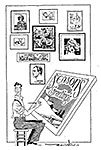
He
couldn't afford to have the card printed, but his mother, who (until then)
hadn't held much hope for his career as an artist, saw "something" in
the card (as Weiss said), and she dipped into scant family savings for it to be
printed. Weiss sent it around to all the cartoonists and illustrators he'd
met, including Lank Leonard, then sports cartoonist for the New York
Sun and the George Matthew Adams Syndicate.
Leonard
had just started Mickey Finn, a strip about a kindly young work-a-day
policeman and his Irish family, and he was looking for an assistant. Seeing
among the pictures behind Weiss a rendition of Edwina Dumm's Tippie, Leonard
phoned Edwina and asked whether she knew anything about Weiss.
"Of
course, she put in some nice words for me," Weiss said. And Leonard sent
Weiss a wire, asking him to come to visit him at his Port Chester studio.
Leonard
picked the youth up at the train station. "And when we drove up to his
house and got out of the car," Weiss said, "a bunch of kids were
playing in the street, and they greeted him, Hello, Lank—Hello, Lank—Hello,
Lank. And I thought, This must be a nice man if the kids are calling him by
his first name."
And
the first time Weiss called him "Mister Leonard," Leonard corrected
him: "Not Mister Leonard—Lank." Leonard watched Weiss ink some
backgrounds for about ten minutes and then hired him. Leonard was twenty years
older than Weiss; it was the beginning of a lifelong friendship. "He was
both a big brother and a father to me," Weiss said.
Mickey
Finn, which had started April 6, 1936, was only a few weeks old at the
time. "Leonard got the idea from an Irish cop in Port Chester,"
Weiss told me. "Named Mickey Brennan, he was wonderful with kids. He
directed traffic after school, and there were always a bunch of kids around
him. That was the inspiration for Mickey Finn." 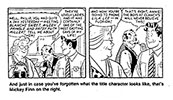
Weiss
stayed in Port Chester for half the week, working with Leonard; then he went
home to the Bronx for the other half of the week. At first, he inked
everything in the strip except the faces and hands of the characters, which
Leonard did. One day several months later, that changed.
Leonard
was an avid golfer, and he often left Weiss in the studio to ink the strips
while he played a few holes of golf. On one such occasion, Weiss had finished
all he was allowed to ink and contemplated a wait of two or three hours before
Leonard would return to finish the strips. And since Weiss would then deliver
the strips to the syndicate office in Manhattan, he knew he would have to wait
for Leonard to do his inking. Altogether, he was facing three or four hours of
enforced idleness.
"By
then I was pretty confident of my inking," Weiss said, "so I went
ahead and inked the faces and hands. Lank came in two-and-a-half hours later.
I heard him come in and take a shower. And then he came into the studio and
sat down at the drawingboard and said, ‘Okay—give me the strips.’ And I gave
him the strips, and he looked at them and said, ‘You son-of-a-gun: you inked
the faces and the hands!’ From that day on, he never inked a line on the
strips."
After
he'd been with Leonard for about six years, United Features Syndicate hired him
to draw Joe Jinks, the strip he'd left years ago. The assignment filled
out the week: continuing to do Mickey Finn for three-and-a-half days a
week in Port Chester, he did Joe Jinks in the remaining half-week at
home in the Bronx. This routine continued until he was drafted into the Army
in 1944.
When
he was released from active duty in 1945, Weiss didn't return to either of the
strips he'd been working on. Instead, he began writing and drawing teenage
comic book stories for Stan Lee at Timely Comics. He worked on Tessie
the Typist, Margie, Patsy Walker, and Miss America as well as
some love and funny animal books for other publishers. He also assisted Al
Smith on Mutt and Jeff occasionally. And in 1948, he joined the
infant National Cartoonists Society, in which he remained an active member for
years until he moved to Florida.
During
this period, Weiss had a strange encounter by phone with the creators of
Superman, Joe Shuster and Jerry Siegel:
"Shuster,
who was the artist, called me up one day and asked me if I would write a comic
strip that he would draw. And I told him I wasn't interested. And strangely
enough, about a week or so later, Siegel called me up and said he wanted to
write a comic strip if I would draw it. But I told him I didn't have time to
do it either."
This
was right about the time that Shuster and Siegel’s 10-year contract with DC
Comics was on the cusp of expiring, leaving the two unemployed after a decade
doing Superman. Shuster and Siegel would soon produce Funnyman, a
short-lived comic book that debuted with a cover date of January 1948, but
before they settled on Funnyman, they apparently each thought again of pursuing
independent careers. (For the story of Funnyman, see Hindsight for
November 2006.)
In
1960, Weiss rejoined Leonard, then ensconced in Florida. "He was then
living in Miami Shores," Weiss said, "and he wanted to know if I
would join him again with the idea of eventually taking over the strip. So
that's what brought us to Florida. On the drawing, we did the same as before:
Lank would pencil the drawings (unless he was sick and then I would do the
pencils, too—and I always pencilled the girls because Lank couldn't draw a
pretty girl), and I would ink."
Weiss
worked on the stories, too: "We would talk over the storyline, and he
would be the final word on the story. And then he would pencil in the strips,
doing the writing and the drawing, and I would look over it, and if I didn't
like something, we would talk it over."
Then
in 1968, Leonard had a heart attack. Weiss recalled: "When he got out of
the hospital, he said, ‘I'm through with the strip; I want you to do everything
now, the writing and the drawing.’ And I said, ‘I'll do it on one condition:
that you don't see the strip at all until it comes out in the paper because if
I'm going to write it, I'm going to do it my way, and my storyline may be a
little more daring than you would do.’ And he said, ‘That's fine.’
"I
did that for the next two years or so until he died. In that two years, when I
would see him, he would say, ‘Hey, I liked what happened today—what's going to
happen tomorrow?’
"I
told him at the time, if you're unhappy with the story that I'm writing, then
we'll cease. But he was very pleased, and the strip held his interest, which
to me was a great compliment. And in those two years, he didn't want the
syndicate to know that he wasn't doing it any longer, so his signature stayed
on the strip. When he died (August 2, 1970), I carried on for another seven
years."
Before
Leonard died, Weiss took on yet another comic strip chore: "After I'd
been with Lank for a year or so, Charlie McAdam [of McNaught Syndicate] called
me up and asked me to lunch. And he said, ‘I'll pay you more money than Lank
is paying you if you'll do the Joe Palooka strip, the writing and the
drawing.’ And I said, ‘No, I won't leave Lank; it's a matter of
loyalty.’"
But
later, Weiss had another idea: he offered to write the continuity for Joe
Palooka, and McAdam took him up on it. Tony DiPreta continued to
draw the strip, and Weiss wrote it. But he didn't want his name on the strip:
"It
already had the signature stamp of Ham Fisher as well as DiPreta's name,
and three names would clutter up the strip. I told them that as long as my
name was on the checks that I got every week, I'd be quite happy."
For
the next several years, Weiss wrote Joe Palooka and wrote and drew Mickey
Finn.
How
did he do the writing for someone else, I wanted to know: "What did you
give the artist? Rough drawings?"
"No,
no," he said. "Just the story. If I introduced a new character, I
would tell him what the new character would look like, but I don't remember
ever giving him any drawings because I think Tony would have been offended at
that: when he saw the character described, he would realize how the character
should look."
"So
you gave him a script, like a movie script?" I asked.
"No,
not like that. I would put it into boxes, panels like a strip, and I would put
the balloons in, and I would have the tail come from Joe or Ann or Jerry."
I
said: "So in effect, you were writing just as you probably wrote your own
strip: you wrote the speech balloons out, right into the strip's panels."
"Yes,"
he said.
I
continued: "So if you're doing a week's Mickey Finn strips, say,
you first did breakdowns—breaking the story into panels—day-by-day, but you had
no written version of the story that you were working from except what was in
your head?"
"Yes,
the story was always in my head because that way you have flexibility," he
said. "A lot of times I would change the story as I went along."
I
remembered something Milton Caniff had told me: "Milton used to
say that if he got a letter from a reader that indicated the reader had figured
out what was going to happen next, he would change the ending."
Weiss
laughed. "Sometimes I would try to do that, too," he said, "—to
get a twist. I tried to fool myself. And I did that one time with one of the
Joe Palooka fights. It looked like he was going to win, but I had him lose
it."
"Joe
Palooka lost a fight?" I asked, incredulous.
"Yes,
I had him lose twice."
In Mickey
Finn, Mickey's Uncle Phil almost took over the strip, even while Leonard
was producing it. Phil was a genial but somewhat fatuous character, whose
harmless boasting made him the perfect fall guy, and as such, he provided comic
relief in the stories. Eventually, the Sunday strip focussed exclusively on
his antics and misadventures in his club, the Goat Hill Lodge of the Ancient
Order of American Grenadiers.
In
the dailies, Weiss alternated straight Mickey Finn detective stories with
humorous ones about Uncle Phil. I asked him if it was easier to do a straight
story than a humorous one.
"I
think so," he said. "But sometimes you'd hit on a good one that sort
of wrote itself. But it's interesting: most actors that I know will tell you
that it's easier to play a straight character than to play comedy. Comedians
will have much more success in a dramatic role than a dramatic actor in a comic
role. It's maybe easier to get someone to cry in a movie than to laugh."
"Where
did you get story ideas?" I wanted to know, unearthing the oldest
interview chestnut of them all.
"You
never know," Weiss said with a grin. "Edwina told me that years
ago: You'll never know where you get ideas from, she said, but you'll get
them. You just never know. I would try —when I came close to the end of a
story, my mind was already wondering where I would go next. I watched movies.
I watched television. I read papers. And if I saw something I liked, I would
say, How can I twist it around and use it?"
"It
might be a newsstory, a news item—"
"Yes,"
he said, "that happened quite a few times."
One
of the first stories Weiss did after Leonard retired sprang from Weiss's
childhood love of the movies. Fascinated by the silent flickers he saw in the
neighborhood theaters of New York's Lower East Side (to which his family had
moved from Philadelphia when he was nine), he revisited some of his favorite
movie stars by doing a story about many of them who were still around in 1968.
"Richard
Lamparski, the author of those I-wonder-what-became-of books, was kind enough
to give me phone numbers and addresses of the actors and actresses, since I
needed their written permission to draw them in the strip," Weiss
explained. "When I wrote to them, I signed the name Lank Leonard, because
his name still appeared on the comic strip."
Another
of Weiss's favorite stories recounted the culmination of Uncle Phil's courtship
of the attractive widow, Minerva Mutton. "It was an on-again, off-again
romance," Weiss said, "so I decided to invite the readers to vote on
whether Uncle Phil and Minerva should get married. They mailed their ballots
in care of their local papers. 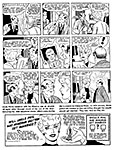
"When
Lank read the strip that invited readers to vote, he said, ‘This is a gamble I
would never take: what if the papers don't receive much of a response?’ It
was a calculated risk since Mickey Finn was losing papers at an alarming
rate at the time. By 1970, newspapers were folding, and each collapse reduced
the number of outlets for comic strips. Continuity strips were definitely on
the way out.
"The
response, however, was overwhelming," Weiss continued, "more than
150,000 letters came in. A minister even volunteered to perform the marriage.
Had Mickey Finn been a King Features strip, they would have publicized
the event with a double-page ad in Editor & Publisher."
Weiss's
first audience was always his wife, Blanche. An accomplished artist in her own
right, she is also, Weiss said, "a great editor and story
consultant."
Mickey
Finn survived for almost eight years after Leonard died. In the end, the
evaporation of newspaper outlets reduced the income from the feature so
drastically that Weiss and McNaught decided to discontinue it with the release
for September 10, 1977. He had stopped writing Joe Palooka by then for
roughly the same reason: the job no longer paid enough to justify the effort.
Suddenly,
as Weiss tells it, he was a free man. "I was like a man let out of
prison," he said. "No more deadlines after forty-two years. A few
months later, I was sitting with a cartoonist friend in New York shortly after Ernie
Bushmiller died. I had done a few Nancy comic books when I was
doing comic books, and my friend knew this, so he told me that the United
Features Syndicate was looking for me in regards to continuing Nancy, a
big money-making strip. But I said, ‘Don't tell them where I am: I've had it
with deadlines; I value my freedom too much,’" he finished with a laugh.
"When
you were starting out," I asked, "did you think you would ever be
doing your own strip?"
"When
I started out, I had doubts, probably like everyone," he said. "And
when I went around and visited cartoonists, I would ask them if they thought I
had enough talent to make it in the business. I needed reassurance. I had no
background. I remember taking some of my drawings to Burris Jenkins, who was then doing sports cartoons for the Journal American, and I said,
‘Mr. Jenkins, do you think I have enough talent to make it?’ And he was very
angry at my question. And he said, ‘Talent won't do it for you.’ He said,
‘It's how hard you're willing to work. It doesn't matter how much talent you
have; someone can have much more talent than you, and they won't get anywhere.
But if you're willing to work and work and work, and learn and learn because
you have so much to learn, then you'll make it.’
"And
that was the best answer I could have hoped for," Weiss said.
"Because it meant I could make it if I kept drawing and drawing and
working and working."
"Interesting,"
I said. "It was the drawing you were looking for reassurance on. You
didn't walk in with a story in your head and wonder if you could do a story.
What you wanted to know was, would they tell you that you could draw well
enough. And I guess you assumed that if the day came that you were doing a
strip, the stories would arise by themselves somehow."
"Exactly,"
Weiss said. "But what I didn't know was that the ability to write doesn't
come until later years. When I was twenty-five years old, I started a gag
feature for the Philadelphia Ledger Syndicated called It Never Fails.
And it didn't go anywhere. It failed. I wasn't the humorist; I learned that I
wasn't a gag writer.
"Even
when I was doing the Joe Jinks strip," he continued, "I was
just drawing a story written by someone at the syndicate. I don't think I had
the ability to write until I was maybe thirty years old, until I came out of
the Army. The two years I spent in the Army I think matured me to quite a
degree."
I
said: "But as a young man, you never even thought about writing ability
being important."
"No,"
he said, "the drawing was everything. I figured the story would come. I
didn't realize then that the story is more important than the drawing."
After
what he called his "demise as a cartoonist," Weiss at first
panicked. He called Stan Lee, and although Lee told him he could give him all
the work he wanted, when he found out it was straight illustrative work, he
said, "Oh, no—I'm not going to work that hard. And that was the end of me
as a cartoonist."
But
he had been collecting original paintings and cartoon art all his life, and
when he found out friends of his were looking to acquire the kind of art he was
collecting, he turned his hobby into a new career.
"I
gave it more time," he said, "and I was able to find more paintings
that friends of mine wanted. I became a sort of art dealer—also enhancing my
own collection."
I
looked around the room of his home that we were sitting in. The walls were
festooned with paintings large and small—Leyendecker, Rockwell, Gibson, Flagg,
Abbey, Christy, Harrison Fisher, 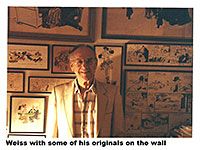 Dean Cornwell, Norman Price, and so on. These
were the great illustrators of America's great age of magazine and book
illustration. There were also paintings by his wife Blanche and his son Jerry,
both accomplished artists. Dean Cornwell, Norman Price, and so on. These
were the great illustrators of America's great age of magazine and book
illustration. There were also paintings by his wife Blanche and his son Jerry,
both accomplished artists.
Weiss
continued: "And I had time to devote all my energy to art collecting—to
go to auctions, to make phone calls, and I was very happy. I didn't have deadlines
anymore," he said with a broad grin.
FOOTNOTE:
Weiss died May 18, 2014 in his home at West Palm Beach, Florida at the age of
98. For the story of his involvement with Ham Fisher during the famed feud with
Al Capp, see Hindsight for January 2013, “Hubris and Chutzpah.”
Return to Harv's Hindsights |